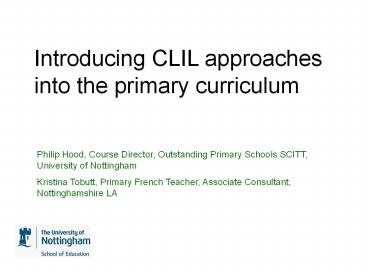Introducing%20CLIL%20approaches%20into%20the%20primary%20curriculum - PowerPoint PPT Presentation
Title:
Introducing%20CLIL%20approaches%20into%20the%20primary%20curriculum
Description:
Kristina Tobutt, Primary French Teacher, Associate Consultant, Nottinghamshire LA ... A La Fran aise Kristina Tobutt, published by Authentik, Dublin ... – PowerPoint PPT presentation
Number of Views:147
Avg rating:3.0/5.0
Title: Introducing%20CLIL%20approaches%20into%20the%20primary%20curriculum
1
Introducing CLIL approaches into the primary
curriculum
Philip Hood, Course Director, Outstanding Primary
Schools SCITT, University of Nottingham Kristina
Tobutt, Primary French Teacher, Associate
Consultant, Nottinghamshire LA
2
CLIL approaches work best when we also.........
- ....use the language for real purposes in a
variety of ways within the primary school day.
For example - orally for classroom organisation, management,
socialisation, and for whole-school functions
such as assembly - in written form, for notices, messages and
display. - And when we also try to make school-to-school
links which share curriculum-based work as well
as personal information.
3
We can begin with simpler cross-curricular work
linked to specific subject areas or topics.
Whole module CLIL approaches in primary
schools already exist in Spain see
http//phobos.xtec.cat/cirel/cirel/index.php?optio
ncom_contentviewarticleid46Itemid74. Partia
l immersion has been tried in Scotland.
See http//www.scilt.stir.ac.uk/projects/evaluati
onwr/documents/EPPI_BOOK.pdf
4
Why would we do this?
Language learning benefits from regular exposure
to language, especially when real purposes are
involved. (See Krashen on comprehensible input,
e.g. summary at http//www.sk.com.br/sk-krash.html
) Good practice language teaching helps develop
a range of skills, such as listening skills,
concentration skills, memory skills,
problem-solving skills, communicative competence,
social skills, self esteem, and can therefore
contribute both to whole child development and to
the whole curriculum. See Hood, P. (2006) Can
Early Foreign Language Learning Contribute to the
Shared Emotional and Motivational Landscape of a
Primary School? Pastoral Care in Education Volume
24 Issue 4, Pages 4 - 12
5
What are children really capable of?
Watch the videoclip and note how children are
accessing language, using language receptively
and using language productively. How is
repetition being used? What are they learning?
Repetition Routines (Greeting song)
Choosing a song from familiar repertoire
Language within story story re-readings
Making the face teacher questioning to range of
pupils Making the mask teacher instructions
spoken as often as necessary NB NO
PARROTING!
6
Language competence and progression-1
When we speak of language competence we often
think of what children can say and later what
they can write. We should also think of what they
can understand, at first by listening and reading
with a teacher, and later by reading more
independently. In terms of longer term
progression, are receptive skills or productive
skills more important, or are both of equal value?
7
Language competence and progression
- Measuring out and back
- Teacher chooses the language to be learned
- Teacher presents and practises the language-set
via repetition games - Teacher finds ways to elicit language
- The aim is that all learn the defined set as far
as they are capable
- Building receptive capacity
- Teacher uses language for real purposes in a
natural way. - Teacher scaffolds language use with visual
support and natural repetition. - Real purposes include any activity involved in
teaching, learning, organisation, management,
socialisation. - Language is produced by learners where they are
able but all develop receptive capability
they actively seek meaning and cognitively
engage.
8
Examples of embedding into the curriculum
Simple one-off activities, building on familiar
material Maths1 Maths2
Using authentic material as stimulus and
providing simple follow-on tasks food
pyramid link
Simple material within a curriculum area La
Réunion material from A La Française
Structured material around a topic theme Matisse
material from A La Française videoclip Les
Grandes Découvertes
9
link
10
Sources and further examples / information Moder
n Languages in the Primary School Philip Hood
and Kristina Tobutt, published by Sage, expected
May 09 A La Française Kristina Tobutt,
published by Authentik, Dublin http//www.authenti
k.com/featured/a-la-francaise.html

























![[DOWNLOAD]⚡️PDF✔️ Introducing the History of the English Language PowerPoint PPT Presentation](https://s3.amazonaws.com/images.powershow.com/10052365.th0.jpg?_=20240610114)
![[DOWNLOAD]PDF Introducing the History of the English Language PowerPoint PPT Presentation](https://s3.amazonaws.com/images.powershow.com/10054016.th0.jpg?_=20240612129)



![[PDF] Introducing the LSAT: The Fox Test Prep Quick & Dirty LSAT Primer Paperback – December 25, 2012 Full PowerPoint PPT Presentation](https://s3.amazonaws.com/images.powershow.com/10078410.th0.jpg?_=202407130910)
